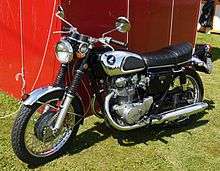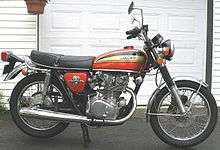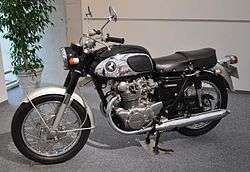Honda CB450
|
1965 Honda CB450 | |
| Manufacturer | Honda |
|---|---|
| Also called | Dream, Hellcat |
| Production | 1965–1974 |
| Predecessor | CB77 |
| Successor | CB500T |
| Class | Standard |
| Engine | 444 cc (27.1 cu in) DOHC straight-2, two 32 mm (1.3 in) CV carburettors[1] |
| Bore / stroke | 70 x 57.8mm[2] |
| Compression ratio | 8.5:1[2] |
| Top speed | 180 km/h (110 mph) (claimed) |
| Power | 43 hp (32 kW) @ 8500 rpm (claimed) |
| Torque | 27.6 ft lb @ 8500 rpm (claimed)[1] |
| Ignition type | Coil with auto-advance,[2] twin contact breakers[1] |
| Transmission | 4 or 5 speed |
| Frame type | Tubular semi-duplex[1] cradle with single front down-tube[2] |
| Suspension | Telescopic front forks with two-way damping, rear swing arm, shock absorbers with adjustable preload[2] |
| Brakes | Drum, 8 in (200 mm) twin leading shoe at front[1] |
| Tires | 3.25x18 front, 3.50x18 rear[2] |
| Wheelbase | 53 in (1,300 mm) |
| Dimensions |
L: 82 in (2,100 mm) W: 31 in (790 mm) H: 42 in (1,100 mm)[1] |
| Weight |
412 lb (187 kg)[1] (dry) |
| Fuel capacity | 3.5 gallons (UK Imperial gallons) |
| Oil capacity | 5 pints[2] |
| Fuel consumption | 65mpg (UK Imperial gallons)[1] |
| Related | 12 volt alternator, 12 Amp Hour battery, 30/35 watt headlamp, standard mirrors and comprehensive toolkit[1][2] |
The Honda CB450 was the first 'big' Honda motorcycle with a 444cc 180° straight twin, dual overhead cam engine producing 43-45 horsepower (more than 100 HP/ litre).[3]
The early models were often known as 'Black Bomber',[1] were notable for their distinctive large chrome-sided fuel tank with the same common 'family' styling used in the S90 and CD175. In Canada the K1 model was marketed as the 'Hellcat'.
Variations
The initial K0 models, known as 'Black Bomber' or 'Dragon'[4] was first shown in UK during the Diamond Jubilee Brighton Speed Trials of September 1965, traditionally held along the seafront. As the bike was newly imported, the engine was not run-in, so the appearance was a semi-competition demonstration sprint run for publicity ridden by (the late) Allan Robinson, MBE,[5] a Honda staff member, recording a standing-start kilometre time of 30.1 seconds and a terminal speed of 100 mph (160 km/h).[6]
The CB450 was then publicly exhibited at the nearby motorcycle show, held for the first time in Brighton at the Metropole Hotel exhibition centre situated on the seafront.[7][4]
When first evaluating the bike in December 1965, David Dixon, a staff writer for UK magazine Motor Cycle reported that UK sales were planned from February 1966.[2] The price of £360 (GBP) quoted at introduction in the February 1966 Official Honda advertisement[1] was about the same as a traditional UK 650 or 750 sports model.[8]
Honda (UK) planned a further publicity event by entering Mike Hailwood as one of the riders in the Motor Cycle 500 mile production race at Brands Hatch during July 1966. Instead, Hailwood completed demonstration laps[9] on a CB450 before racing began as it was unable to compete in the 500cc category, the FIM deeming it was not classified as a production machine as it had two overhead camshafts.[10]
Although the CB450 never sold up to Honda's expectations, it had excellent engineering for the time, notably including reliable electrical components, an electric starter, and a horizontally split crankcase, all features distinct from the British twins of the era. The most radical feature was the valve springing. Instead of the conventional coil springs, it used 'torsion bars' - rods of steel that twisted to provide the spring effect.[11]

The four-speed K0 model was updated in the K1 model produced from 1968 with a redesigned fuel tank, rubber-gaitered front forks instead of sliding metal shrouds, a five-speed gearbox and twin speedometer and rev-counter instruments mounted above the headlamp.[4]

Later developments progressed through a series of 'K' models with various improvements and styling changes including a single front disc brake, continuing to K7 versions in some markets, until the introduction of the CB500T in 1975.[12]
The basic engine was modified and installed in the Honda N360 car and the exported N600, the precursor to the Honda Civic.
References
- 1 2 3 4 5 6 7 8 9 10 11 Motor Cycle, 17 February 1966. Colour centrespread official Honda CB450 UK advertisement. "Meet the big black bomber..." "£360.0.0" Accessed 2013-08-22
- 1 2 3 4 5 6 7 8 9 Motor Cycle, 30 Dec 1965, p.910 to 913 Road impressions of new models. Honda CB450 by David Dixon. Accessed 2013-08-21
- ↑ Margie Siegal (July–August 2007). "1971 Honda CB450 K4". Motorcycle Classics. Retrieved 2009-08-11.
- 1 2 3 Motorcycle Mechanics, January 1968, pp.19-20. Full Chat" by John Day. Five speed 450 Honda Accessed 2015-06-01
- ↑ Allan Robinson, MBE. Obituary Retrieved 2013-08-23
- ↑ Motor Cycle, 16 September 1965, p.424. Brighton Speed Trials results. Accessed 2013-08-23
- ↑ Motor Cycle, 9 September 1965, Brighton Show Edition. 'Honda, Stand 15'. "This is what we've all been waiting for—the sparkling new 444cc Honda CB450. Its on show for the very first time in England". Accessed 2013-08-24
- ↑ Motor Cycle, 9 September 1965, Brighton Show Edition prices in GBP for 1966 range: Triumph Bonneville 650 £349, BSA Lightning 650 £355, Matchless G15CSR 750 £370, Norton Dominator 650SS £361, Norton Atlas £369. Accessed 2013-08-24
- ↑ Motor Cycle, 7 July 1966. p.22/23 Scratcher's Marathon. Motor Cycle's 500—mile race. "A plane was specially chartered to fly riders back from the previous day's Dutch Grand Prix. One who took advantage of this was Mike Hailwood and here [pictured] he brakes as he completes demonstration laps on a Honda CB450 before racing begins" Accessed 2013-08-21
- ↑ Motor Cycle, 19 May 1966, p.664 Racing Line by David Dixon. "The Honda CB450 is not yet regarded as a 'production' machine...the CSI decided not to change the rules—under which machines with two overhead camshafts are barred—as it would be 'unfair to make a chance in mid season'.". Accessed 2013-08-21
- ↑ Margie Siegal (March–April 2010). "Honda CB450: The Black Bomber". Motorcycle Classics. Retrieved 2010-05-21.
- ↑ Bike, October 1975 pp.18-24 500cc Giant Test Accessed 2015-06-01
| Honda motorcycle timeline, 1970s (street) - next » | |||||||||||||||||||||
|---|---|---|---|---|---|---|---|---|---|---|---|---|---|---|---|---|---|---|---|---|---|
| Type | 1970s | ||||||||||||||||||||
| 0 | 1 | 2 | 3 | 4 | 5 | 6 | 7 | 8 | 9 | ||||||||||||
| Scrambler | CL175 | CL200 | |||||||||||||||||||
| CL350 | CL360 | ||||||||||||||||||||
| CL450 | |||||||||||||||||||||
| Standard | CB100 | ||||||||||||||||||||
| CB125S | |||||||||||||||||||||
| CB175 | CB200 | CM185 Twinstar | |||||||||||||||||||
| CB250 | |||||||||||||||||||||
| CB350 | CB360 | CB400T | |||||||||||||||||||
| CM400 | |||||||||||||||||||||
| CB350F | CB400F | ||||||||||||||||||||
| CB450 | CB500T | ||||||||||||||||||||
| CB500 Four | CB550 | CB650 | |||||||||||||||||||
| CX500 | |||||||||||||||||||||
| CB750 | |||||||||||||||||||||
| Sport | CB900F | ||||||||||||||||||||
| CBX | |||||||||||||||||||||
| Touring | GL1000 Gold Wing | ||||||||||||||||||||
| MotoGP | |||||||||||||||||||||
